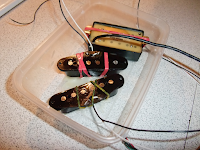



 Finally I've finished this project.
Finally I've finished this project.
It was a bit of struggle at times, but I do this as a learning exercise. If I just wanted a nice wood finish Rhoads I could have bought one. Well, assuming I could find one, Jackson don't actually make one in a plain wood finish.
I was lucky the wood of the top ply I revealed on sanding it was fairly attractive, it could have been nasty, all full of knots and filler.
The 'terrace' tremolo inset I had to do to rescue it after shifting the tremolo forwards is a little odd looking but not totally stupid.
Having taken the finish off the face of headstock it's cleaned up pretty nicely and the waterslide decal worked great after a couple of false starts.
The real reason I saved this though is that the neck is really nice to play and the single coils seem decent.
Wiring the pickups up in series has made a real difference, especially if you do things like use the neck single coil with one coil of the humbucker. It's not like a strat, but much warmer and like a neck humbucker without being at all muddy because the bridge lightens the tone.
I made the humbucker coil split so you can select which coil you use. Used on it's own you can get a choice between the real icepick sound of the south coil or a slightly more usable north coil. Then when used with the other pickups, swapping which of the coils you use doesn't make a massive difference in sound but does mean it can be hum cancelling with either the neck or middle pickup.
The cheap Iron Gear Steamhammer humbucker is quite high output but that just means each coil is pretty well balanced with the single coils and with everything on in series it's kind of like having two standard humbuckers.
Using the two single coils together is very reminiscent of a neck humbucker.
It's really worked out well. But for the fact I think having mini switches looks nasty and is hard to use quickly I'd be doing this on all my future projects where practical.
So I'm going to sign off on this one for now and start looking at the Goth Explorer. I may have to set this up again as it's a bit rattly, but I want to play it some and let it 'settle'.
I kind of want to continue the 'terrace' theme by making insets for the switches and pots but it's not worth tearing it to bits again just now.












































